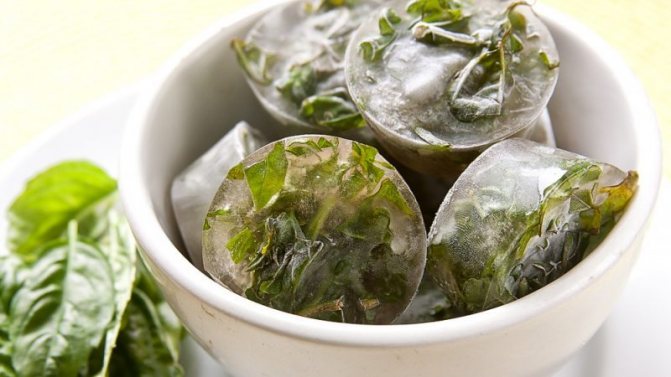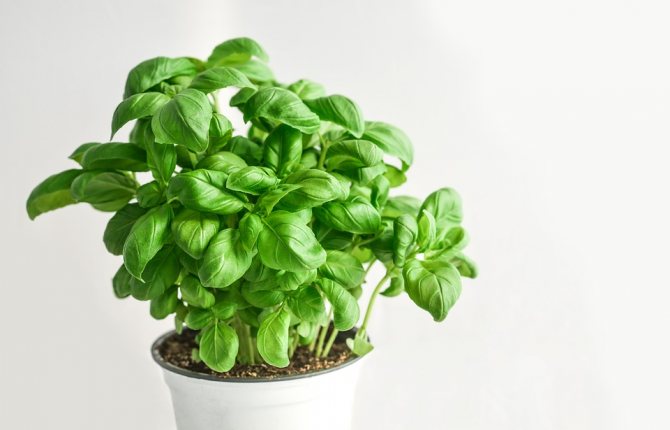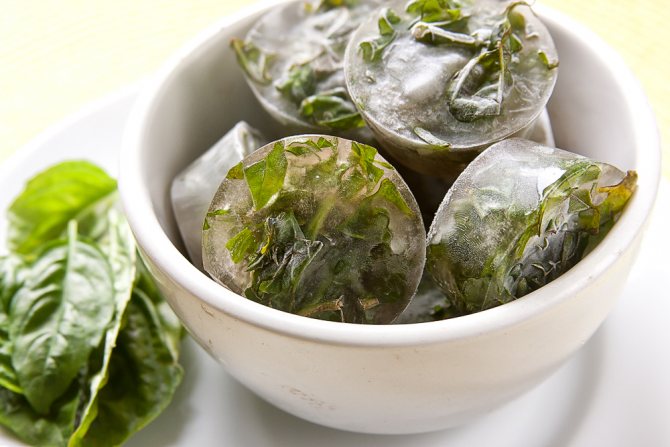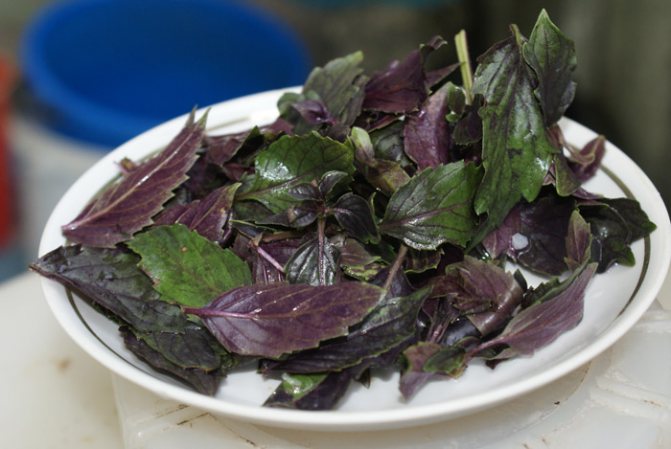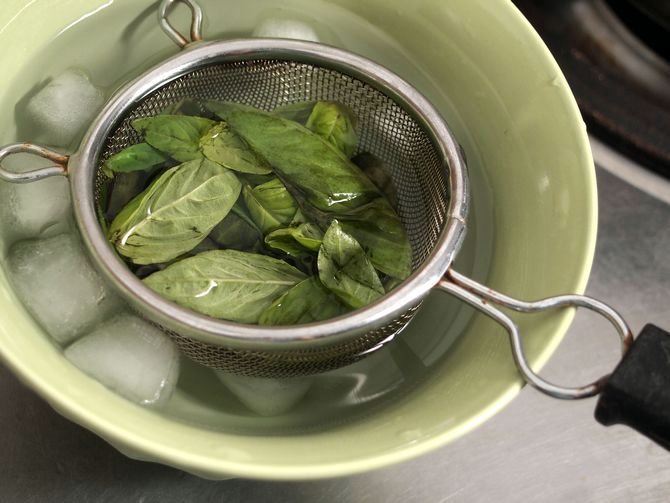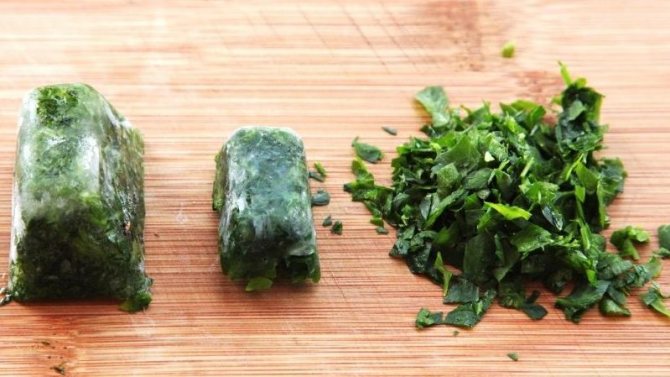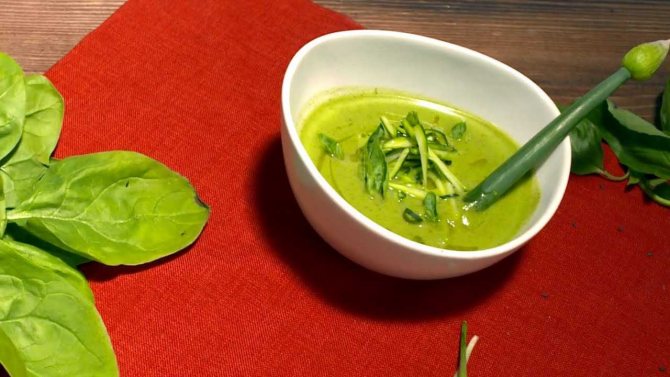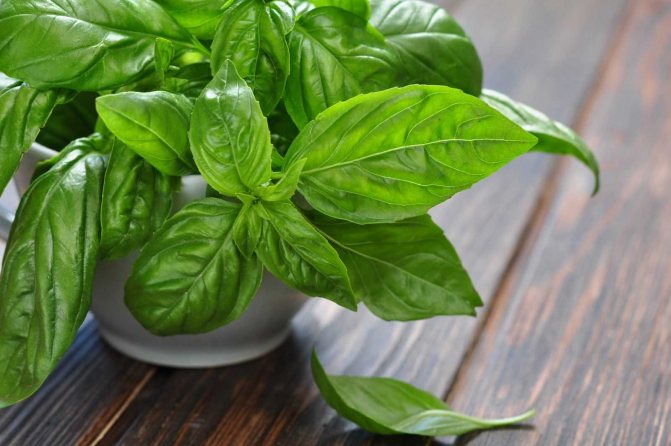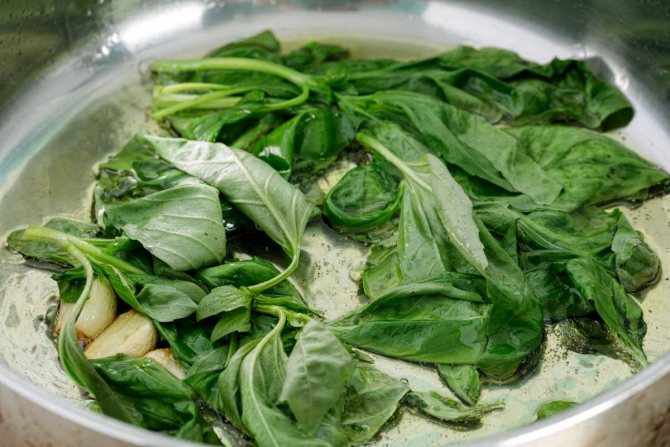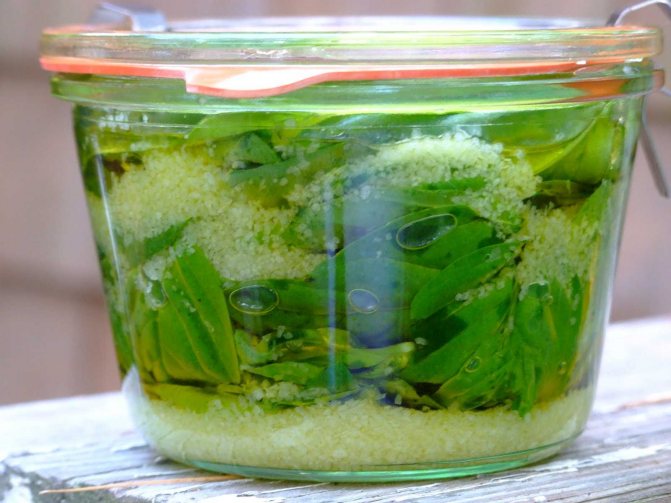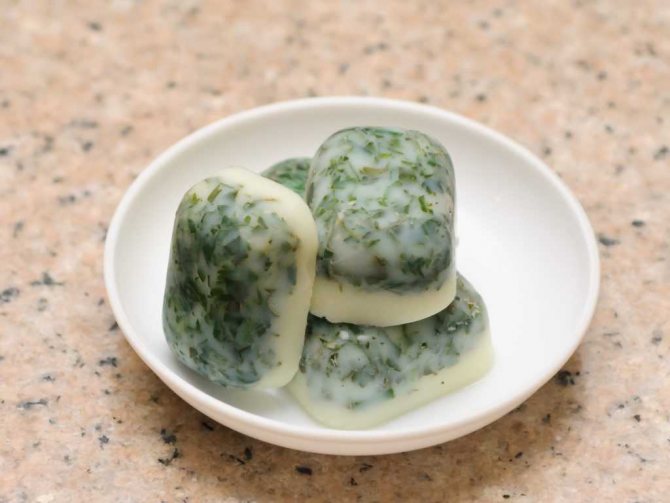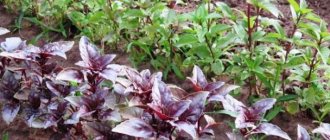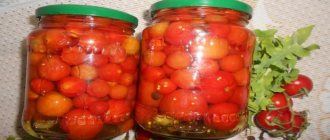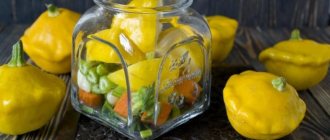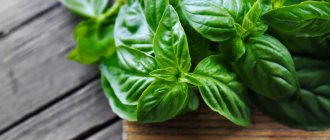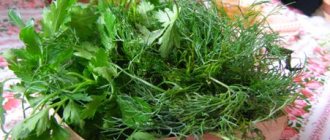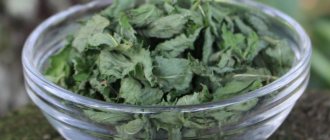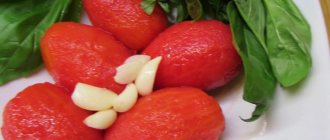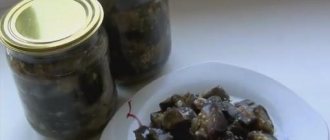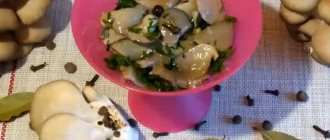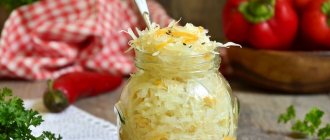Is it possible to freeze basil for the winter
Basil can be bought at almost any grocery store, but the freshness of the plant is questionable. On an industrial scale, it is often temporarily thawed for various reasons, after which it is re-frozen. It is categorically impossible to do this - after repeated freezing, the greens lose all their useful properties.
In this regard, a natural question arises - is it possible to freeze basil for the winter on your own? The answer to this question is simple - yes, you can. At the same time, the quality of frozen greens will always be under control.
Frozen basil is used to make sauces, soups, pastas and salads.
Canning
This method allows you to store basil greens in the refrigerator for several months without losing their beneficial properties. The main secret is that the leaves are kept in boiling water for about a minute and then crushed in a meat grinder. After that, salt, sugar and olive oil are added to the resulting mixture, then sterilized and sealed with metal lids using a seaming key.
To prepare the basil preservation, use the following ingredients:
- basil greens;
- salt;
- sugar;
- olive oil.
Rules for preparing basil for the winter for freezing
There are a number of general guidelines for freezing basil for the winter at home:
- Regardless of the method of freezing, it will be useful to pre-soak the basil leaves in water at room temperature for half an hour. At the same time, salt must be added to the water - if any small insects remain in the greenery, this measure will help get rid of them. After soaking, the greens are thoroughly washed in running water.
- The leaves of the plant must be rinsed even if they have not been soaked before.
- When frozen, the basil may darken, but this will not affect the aroma and taste of the plant in any way. This phenomenon can be avoided by blanching the leaves before freezing. To do this, they are immersed in boiling water for a few seconds.
- In order to prevent the leaves from becoming covered with dark spots after harvesting for the winter, instead of blanching, you can use another means, namely, storing greens in special bags for freezing. In this case, after placing the plant in the bag, it is important to release all the air from it. It is recommended to use ordinary drinking straws to facilitate this process.
- Before freezing, the washed basil is laid out on paper napkins or a towel until completely dry.
- Usually, only the leaves are frozen, separating them from the twigs.
- When adding frozen herbs to dishes, it is necessary to immediately remove the remaining material in the refrigerator to avoid premature defrosting. That is why it is recommended to lay out the leaves in the container in small portions.
- It is very convenient to lay out the basil for freezing for the winter in separate silicone molds or ice containers. The latter, as a rule, have a volume equal to 1 tbsp. l. This makes it much easier to determine the right amount of frozen greens during cooking.
Keeping basil fresh
Maintaining the freshness of fragrant greens is quite difficult due to the specific structure of its leaves, which rapidly begin to darken and lose their own aroma. In this regard, it is recommended to buy only freshly harvested basil, which has no signs of darkening and wilting.
Advice! Basil is sold in bunches, so you need to carefully examine each of them and remove the already darkened leaves, as they can provoke a faster deterioration in the quality of the spice.
Storage of fresh grass is permissible only in places protected from direct sunlight and with sufficient water. It is possible to increase the freshness of fragrant leaves in this way:
- The stalks are cut down into the container, by analogy with a bouquet.
- After that, it is necessary to pour a sufficient amount of water into the container - depending on the volume of the bundle and the capacity of the container, the stems should be closed with liquid by 3-4 cm.
- Storing basil in the refrigerator in this case is not a prerequisite, the main thing is that no light falls on it.
- So the basil will retain its own freshness for 10-15 days.
The upper part of the bouquet, placed in a container with water, can be covered with a plastic bag, and then fasten its edges with an elastic band on the container. In the case of such a package, the freshness of the herb can be maintained for 3 weeks.
When the volume of the spice is not too large and it is planned to consume it for 3-4 days, the stems, along with the foliage, are wrapped in a damp towel and then sent to the refrigerator. There is an option to preserve the freshness of the basil in a crushed form - the cut leaves are placed in a glass container and then a little salt is added to them, poured with a small volume of vegetable (sunflower or olive) oil and closed with a tight-fitting lid. Such a jar must be placed in the refrigerator. The spice retains its freshness and original qualities with this preparation method for 2-3 months.
Freezing basil for the winter at home
You can freeze basil for the winter either in the form of whole leaves or in a crushed state. Also, the plant retains its useful qualities well in the form of puree.
All types of basil are suitable for freezing. There are the following methods of harvesting this plant for the winter:
- fresh;
- freezing with preliminary blanching of leaves;
- pouring seasoning with broth, water or oil;
- in the form of mashed potatoes.
In general, all these methods are very similar, with the exception of some details. Regardless of the freezing scheme, the main thing is to adhere to the basic rules for harvesting greens for the winter in the process.
How to freeze basil leaves fresh
Fresh basil can be frozen as follows:
- The leaves are thoroughly rinsed in cold running water, and then laid out to dry on paper napkins, a baking sheet or a towel. In order to speed up this process, you can gently blot the leaves.
- The dried seasoning is laid out on parchment paper and moved for 30-40 minutes in the refrigerator, in the freezer. It is important to arrange the basil so that the leaves do not come into contact with each other, otherwise they may stick together.
- After this pre-freezing, the seasoning is quickly distributed into individual portioned sachets or containers. Here it is important to have time before the basil is thawed.
- Tightly sealed containers are returned to the freezer for winter storage.
How to defrost properly
Proper defrosting will preserve the beneficial properties of the plant. Some recommendations will help with this:
- Remove fresh frozen basil from the freezer and transfer to the lower shelf of the refrigerator until defrosting.
- Do not thaw whole basil leaves in water - they will give it all their beneficial substances.
- If basil is frozen in cubes and is used to make soup, broth, pasta, or other hot dishes, it should not be thawed first. Just add the required number of cubes to the hot water.
Where can you use
Frozen basil, like fresh basil, is widely used in cooking. It is added to:
- soups;
- meat and fish dishes;
- salads;
- pasta;
- sauces;
- lemonade;
- tea.
Cubes based on olive oil and basil will also be useful for home beauty treatments. They wipe the face - to tone and improve color.
The infusion from the plant will increase appetite, relieve cramps and help with insomnia. In folk medicine, it is used as a remedy for the treatment of gastrointestinal diseases and headaches.
It is interesting:
Do-it-yourself burning blank: is it possible to freeze horseradish for the winter.
How to properly freeze gooseberries for the winter in the freezer: the best ways.
How to properly freeze carrots for the winter in the freezer.
Method 1 - whole leaves
Basil from the market or your own garden can be stored frozen for up to a year, just before the new harvest.
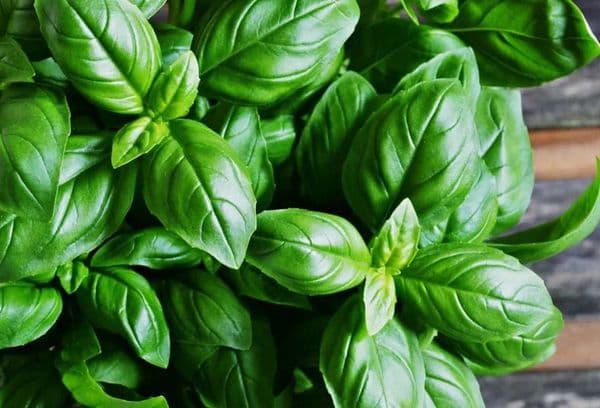
How to freeze whole leaves:
- Freshly harvested leaves must be rinsed thoroughly. Many housewives recommend soaking the basil for a short time so that the water draws out the maximum contamination from it. One hour of "bathing" is enough. Miss Cleanliness magazine recommends changing the rinsing water 2-3 times.
- Now the branches need to be dried. Spread them out on a tray in an even layer, turn over occasionally. Drying at elevated temperatures is not worth it, otherwise the basil will become brittle and will only be suitable for further drying for seasoning.
- Dried basil sometimes looks a little sluggish, but that's no big deal. Just fold in bags and tie tightly.
- It is better to freeze fragile basil leaves in containers, placing them freely. So they will not break, they will look beautiful in a salad.
- If you prefer bags, take two layers so that the bright aroma of greenery does not affect the neighboring products in the chamber. Also, this measure will protect the basil itself from the penetration of extraneous odors.
- Be prepared for the greens to darken slightly during storage. But if you did everything right, then it will remain the same fragrant and healthy.
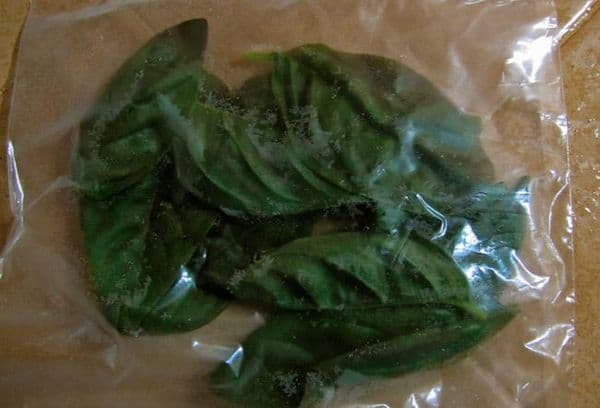

Tip Basil cuttings should not be lignified! Use only soft grassy ones, or do without these parts altogether. Use scissors to cut the leaves off the main branch. By the way, it is also more convenient to chop the leaves with scissors.
The benefits of the plant
Basil is a treasure trove of useful ingredients. It contains vitamins C, B2, PP and A, sugar, carotene, phytoncides, P-rutin.
- It helps the immune system to fight off infections and is an excellent antipyretic agent. Some people use it as a medicine for tuberculosis.
- Due to the content of certain trace elements, the plant is able to dissolve even kidney stones. An infusion of it is taken orally for colitis, gastritis and abdominal pain.
In general, basil is a versatile plant that can be grown in a garden plot or even on a window in an apartment. The spectrum of its healing actions is very wide. But do not overuse its excessive use. In addition to the positive qualities, the plant has some contraindications.
- Pregnant women, regardless of the period, will have to stop eating basil.
- For people who have had a stroke and heart attack, doctors recommend not to use the plant.
- Diabetes, hypertension, coronary heart disease, early childhood - restrictions on the use of basil.
- The period of treatment with drugs based on this plant should not exceed 21 days. Otherwise, you will get the opposite effect. Instead of benefit, the body will be seriously harmed.
- It helps the immune system to fight off infections and is an excellent antipyretic agent.Some people use it as a medicine for tuberculosis.
- Due to the content of certain trace elements, the plant is able to dissolve even kidney stones. An infusion of it is taken orally for colitis, gastritis and abdominal pain.
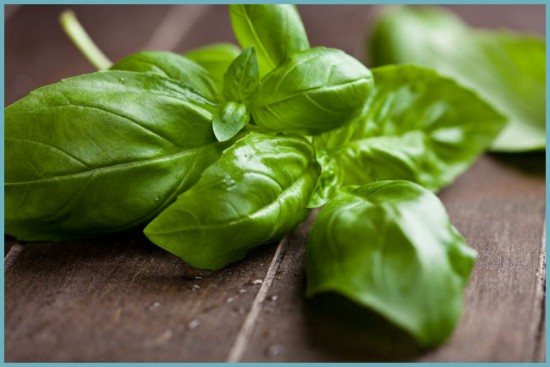

Basil has a lot of useful properties, so you need to include it in the diet all year round. - Helps with toothaches, stomatitis and other unpleasant diseases. Rinsing your mouth with its infusion can kill 99% of bacteria.
- You can get rid of a headache or migraine by eating a few basil leaves.
- It can help people with heart problems fight bad cholesterol.
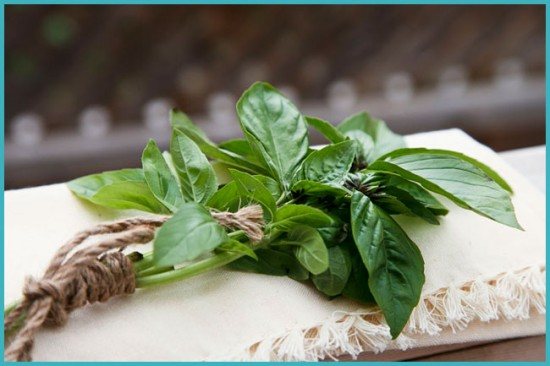

So that there is always fresh basil on the table, it can be planted even on the windowsill in the apartment
Method 2 - chopped basil
If you don't want to spend a lot of time cooking, then take care of the green seasoning in advance: just cut the basil leaves before sending it to the freezer for storage.
- Prepare the herbs as in the first method. Make sure the basil is completely dry.
- Cut the leaves in any convenient way, but do not grind too much.
- Distribute in small bags, tie them as tightly as possible so that there is less air.
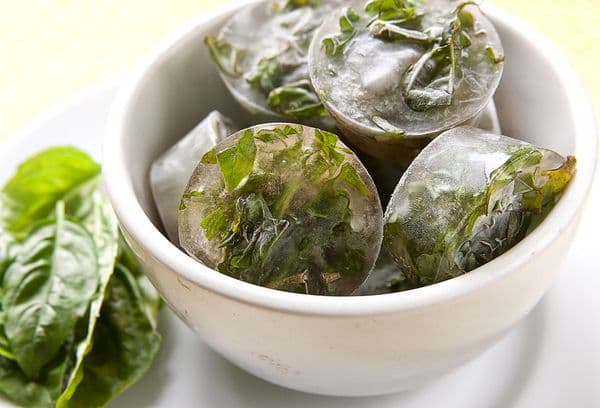

Tip A day after placing the basil in the freezer, take out the bag and shake it slightly and put it back in place. Then the greens will not crumple.
Preparing the main ingredient
Preparation of the ingredient begins by collecting the basil from the garden. Scissors cut off young branches that have not begun to bloom. The part of the stem that has not yet hardened is cut off, seemingly juicy. In the evening, the bush is watered, and in the morning they begin to harvest, so the plant gains moisture and becomes more juicy and soft, especially if it is then frozen.
Collecting the workpiece for drying can take place during the daytime in strong sunlight. The bushes are easy to pull out by the root, if you do not use scissors, but tear off with your hands.
After harvesting, sprigs of greenery are placed on the table and diseased, dry, rotten leaves are removed, you can not use the branches for blanks, but only tear off the leaves.
The prepared leaves need to be rinsed several times with warm running water so that no dust, dirt and possible pests remain on them. I spread the washed grass on a towel and let it drain for a few minutes, after which it is prepared for one of the types of blanks.
Method 3 - with olive oil
Some housewives complain that basil frozen in whole form becomes ugly and loses its shape. There is a simple way out - to make mashed potatoes from it with an addition of butter. Of the vegetable group, the most popular are olive, sunflower and corn. Try not to use oils that are sensitive to low temperatures.
Basil puree with oil is ideal for dressing salads, as a fragrant dressing in soup, for frying, for mashed potatoes, meat and fish dishes, and even for marinades.
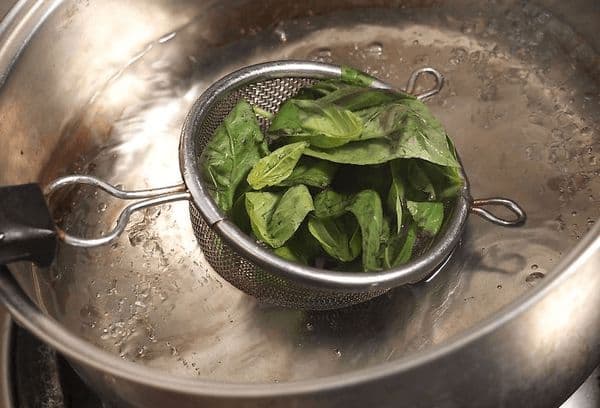

How to cook, recipe:
- Rinse the leaves, dry them on a waffle towel or using a hand centrifuge.
- Grind with a blender until gruel.
- Add about 1 tbsp to a glass of greens. l. vegetable oil.
- Purée the mixture again for a few seconds, or simply stir with a spoon.
- Divide into portioned cakes for ice or baking.
- Send for storage wrapped in two bags.
Tip Use silicone molds - it is most convenient to squeeze out portions of greens from them. From metal and plastic, you will have to pick up the frost with a knife.
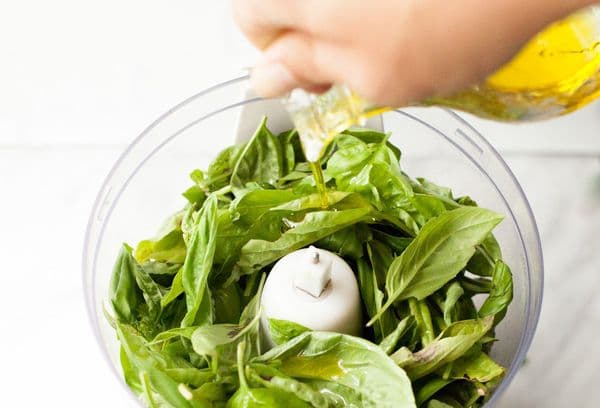

A little trick: in order not to remove the mold with the blank every time, a day after placing it in the chamber, take out the basil, empty the portions and pack them in separate bags.
Basil, celery and parsley seasoning
- basil - 200 g
- garlic - 3 heads
- celery - 1 bunch
- parsley - 200 g
- hops-suneli - 1 pack
- salt - 100 g
- hot chili peppers - 2 pcs.
- Rinse thoroughly and dry all the greens. Scroll everything in a meat grinder, along with garlic and chili. Add the hop-suneli seasoning and salt to the herbs, mix.
- We roll it up in sterilized jars. This seasoning goes well with mayonnaise, sour cream, olive oil.
Method 4 - with butter
Butter is also used as a dressing. Use a product with animal fats, as spreads and mixtures with vegetable oils are difficult to melt and affect the taste of products. By the way, basil dressing can be salted.
- Melt the butter over low heat to keep it from simmering.
- Rinse, dry, and chop the basil leaves in any convenient way.
- Mix with oil and distribute to ice trays, or use small plastic containers.
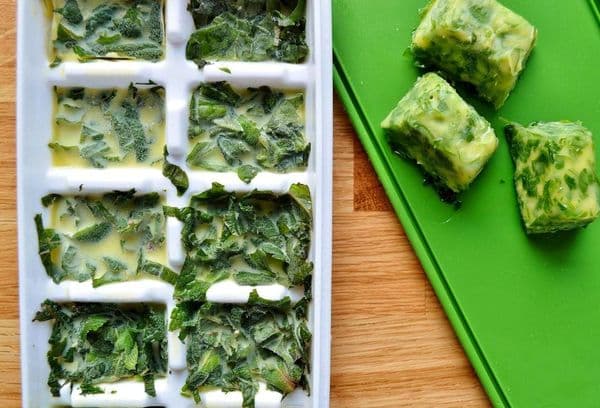

Supplements can be made from both purple and green basil. Both are very aromatic and vitamin-rich.
Basil jam
- green basil - 6 bunches
- water - 500 ml
- cane sugar 1 kg
- lemons - 6 pcs.
- pectin - 1 sachet
- Boil water, dissolve sugar in it, stir, add 1 lemon, cut into thin slices. Boil for another 5 minutes, then add the washed basil leaves to the sugar syrup.
- Cook the mixture for about 30 minutes and add the squeezed lemon juice and pectin. Stirring continuously, cook as much as written in the instructions. Then add lemon zest and cook for 3 hours. When the mass thickens, turn it off, filter it and roll it over the banks.
Read also: How to salt cabbage with slices and heads of cabbage: a recipe with beets, in Caucasian style, instant cooking for the winter
Finally
These were the four easiest ways to prepare delicious basil greens, but the ideas of the hostesses do not stop there. Some people freeze the crushed leaves in water to make ice cubes. Another recipe uses meat broth instead of water. The method with preliminary blanching is popular. For this, the basil is cleaned and slightly boiled over.
Thawing basil is as easy as freezing recipes. If you are cooking on the stove, then simply send the cube of greens to the dish. Long-term defrosting is also not required for dressing salad with whole leaves.
Remember that the longer basil is stored, the less vitamins it retains. Try to use the blanks before spring, and soon a new crop of early greens will appear.
Terms and conditions of storage
Basil paste is stored in the refrigerator, the mixture does not tolerate room temperature. It makes no sense to sterilize the seasoning for the winter - this will destroy its unique taste. Provided that the preparation and packaging are sterile, the paste will last for at least 12 months.
The addition of salt will extend the shelf life of the basil. But even if fully preserved, the sauce will begin to lose flavor after 4 months. Vegetable oil reduces the lifespan of the unique bouquet of flavors to 90 days. Basil harvested in early autumn will stand without loss until the New Year holidays. Further, its properties gradually decrease.
After opening the sealed workpiece, the composition quickly deteriorates, therefore, small containers should be used for preservation. Sometimes it is recommended to freeze the pasta: it is convenient to add portioned cubes to dishes, and they have a longer shelf life. But this method will greatly affect the taste - the sauce will become less spicy.
Step by step recipe with photo
Basil is a fragrant "green" known in cooking, used as a salad ingredient, seasoning for meat dishes, sauces, soups, as well as for preservation and salting. Quite often, housewives began to use the technology of freezing seasonings for future use. Properly frozen basil leaves are stored for about a year, while remaining aromatic without losing their properties.We will try a quick and convenient way of preparing the most fragrant basil for the winter by freezing in two quick ways.
I grow purple basil in my summer cottage. This variety has a special spicy aroma that my husband really likes. We add grass to meat or poultry, and also use it to make soups, salads and snacks.
Slightly touch on the sowing and cultivation of this amazingly bright and tasty seasoning - suddenly someone will come in handy. Basil loves warm soil and sunshine. It is more convenient for me to grow grass in a greenhouse, because with consistently warm weather, it begins to be delivered not earlier than July. I sow seeds in early June in a large pot. Water abundantly, and then cover with foil until germination. Then I remove the film, continue watering as needed. When the second leaves appear on the sprouts, I dive into the greenhouse in rows. Here is such a pretty purple basil I have by mid-July.
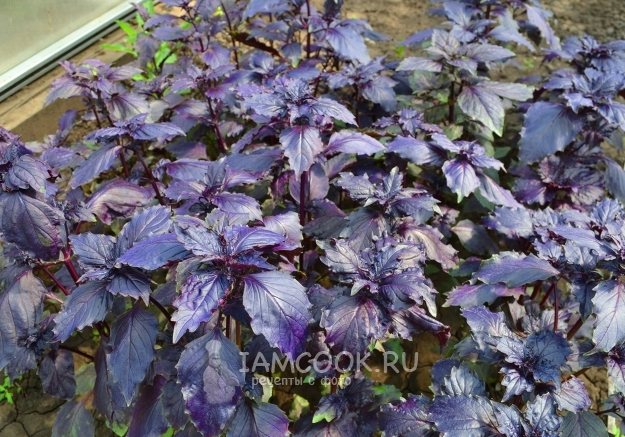

Let's prepare the basil and olive oil. Previously, greens must be soaked in cold water, and then dried naturally. I fill the jar with water. I put a wet bunch of basil in it. In hot weather, you can start freezing in an hour.
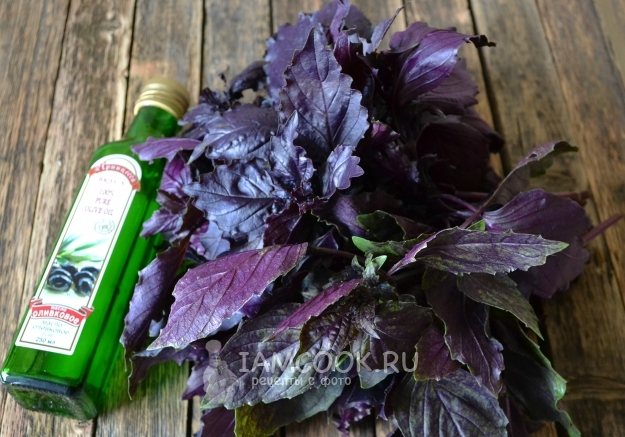

Method 1. Freeze basil leaves with olive oil.
We pluck the leaves from the bushes. Basil stems are not frozen.
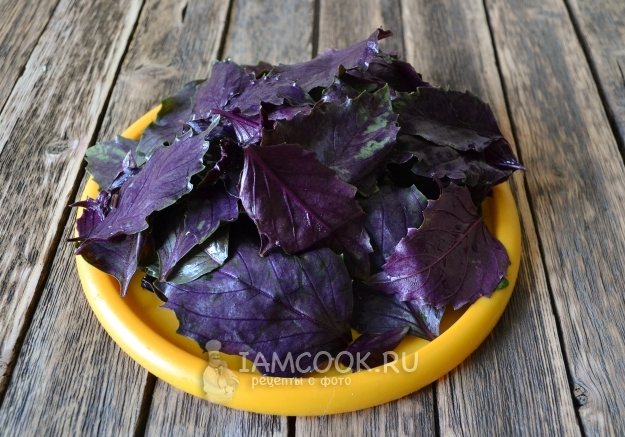

We put the leaves in a plastic container. There may be several storage jars, depending on the amount of seasoning. Drizzle with olive oil. About 1 small container of basil takes 1 tsp. olive oil. We close the lid. We shake the container. We send it to the freezer until winter.
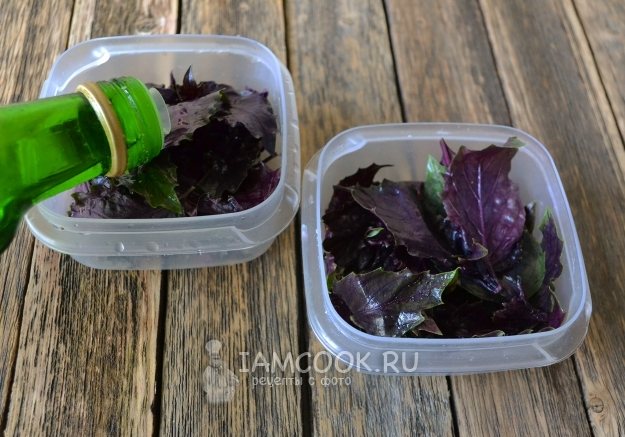

Method 2. Simple freezing.
Basil leaves must be chopped, but not too finely chopped. Fold into a medium container or plastic bag. Close or tie, releasing air. Put in the freezer.
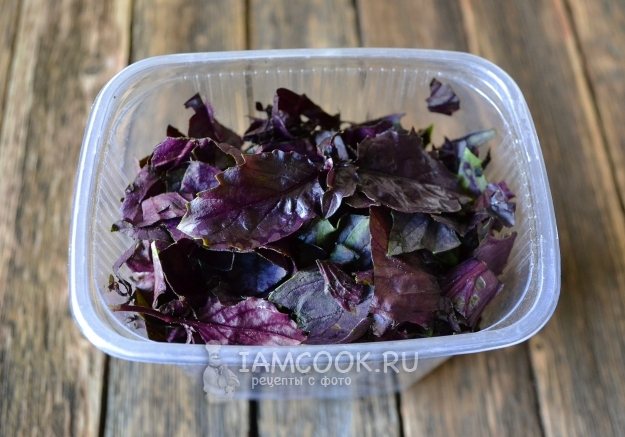

We take frozen basil out of the freezer as needed. We use basil with vegetable oil for making salads, snacks and sauces. Chopped basil - for meat dishes and soups. Frozen basil darkens slightly, but does not lose its properties after defrosting. Stays the same fresh and aromatic.
37
Salting
You can pickle fragrant basil greens in jars, this is a proven storage method. Such blanks can be stored in the cellar or in the refrigerator throughout the winter.
Step-by-step cooking recipe:
- Rinse the basil leaves thoroughly and remove moisture with paper towels.
- In prepared jars of 0.5 liters. we lay a small layer of greenery about three centimeters.
- We make a layer of salt.
- We fill the jar layer by layer and tamp it a little so that the juice appears.
- We close the lids and sterilize the workpiece for 15-20 minutes.
Sequential alternation of layers of green and purple varieties of basil in a jar will look spectacular.
Dry freezing
The dry method includes the following operations:
- harvesting;
- preparation for freezing;
- preparation for storage;
- storage.
Among the several options for freezing basil for the winter, the dry method is one of the most commonly used at home. It is convenient in that the herbs frozen in this way do not take up much space in the freezer and can be stored for a long time, and all the work to preserve the aromatic spice is done quickly and easily. So, in order to freeze basil in a dry way for the winter, you should proceed as follows. Initially, you need to collect greens from the garden and prepare it for freezing. In this case, the basil can be frozen both with whole branches and with individual leaves. The collected spice must be washed well. Correctly, in this case, it will be to soak the greens in a container of water for about an hour, which will completely get rid of the dust that had time to settle on the leaves and stems of the plant.
After the greens have been washed, they must be dried well, which will make the freezing of better quality - the taste of the basil will remain the same bright and rich, and it will be possible to store the spice in the refrigerator for a little longer. The completely finished spice is laid out in plastic bags, from which air is released and tied in a knot. The resulting basil sachets are placed in the freezer, where it can be stored for up to a year. After a day, the package must be taken out and moved. This is done so that the greens do not freeze in one piece, but disintegrate into separate elements, which is more convenient for its further use.
Choosing a storage location
Not every home has a lot of storage space for greenery. The most optimal places are a room, a refrigerator, a shelf for vegetables, a freezer.
At room temperature
Basil lasts only 24 hours without water indoors. To increase this time to 7 days, the bunch is placed in a glass of water. It is changed daily and the roots are cut to the stems. At the end of the term, the plants are discarded or frozen.
In a refrigerator
Some housewives put a bunch of basil in water in the refrigerator. The leaves are separated from the stems, then the leaves are wrapped in cling film. Can also be stored in a plastic container. In this form, the greens remain for 14 days.
In the vegetable compartment
It is known that in the vegetable compartment in the refrigerator the temperature is kept constant at 2 ° C. In such a place, basil will last up to 3 weeks. It needs to be checked daily. It is also better to wrap the leaves or bunch with cling film.
In the freezer
Duration of storage when frozen is 2 years. The leaves are preliminarily separated from the stems. They are washed with water and cleaned of dirt. Blot with a towel, put in a plastic bag or plastic container. Basil is also frozen as a whole, along with the stems. But it should be borne in mind that you will not be able to tear off a couple of leaves from a frozen branch, as they become brittle. We'll have to defrost the entire stem.
Important! A leaflet with the signature of the date of freezing and the time of collection of raw materials is put into a bag with basil.

